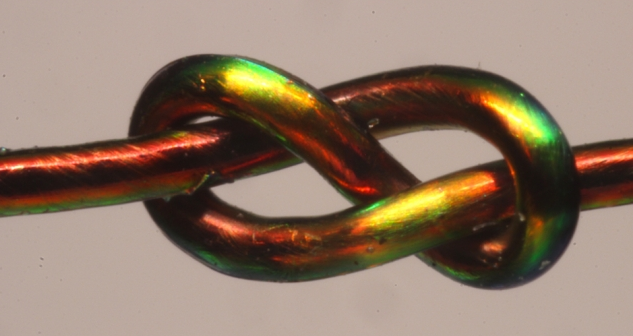We all know that a chain is only as strong as its weakest link. But what about your knots? How strong are they? Now we have answers, and videos, from researchers at MIT who used color-changing fibers and a new mathematical model to predict a knot’s stability.
The math model is based on several things, including the number of crossings involved and the direction the rope segments twist when you pull the knot tight. “These subtle differences between knots critically determine whether a knot is strong or not,” says Jörn Dunkel, associate professor of mathematics at MIT. “With this model, you should be able to look at two knots that are almost identical, and be able to say which is the better one.”
Dunkel worked with Mathias Kolle, another associate professor at MIT and a veteran sailor, and two grad students to develop models predicting the strength of knots. Their results were just published in Science.
They started by engineering stretchable fibers that changed color in response to strain or pressure. When they pulled on a fiber, its hue changed from one color to another, particularly in areas of greatest strain. In working with fibers, and even spaghetti, they developed what they called “counting rules” or characteristics that determine a knot’s stability.
They found that a knot is stronger if it has more strand crossings, as well as more twist fluctuations, or changes in rotation from one strand to another. If a fiber segment is rotated to the left at one crossing, and then rotated to the right at a neighboring crossing when you pull the knot tight, the resulting twist fluctuation and friction add stability. But if the strand is rotated in the same direction at two neighboring crossings, it is more likely to rotate and slip, resulting in a weaker knot. The researchers also found that a knot can be made stronger if it has more “circulations,” where two parallel strands loop against each other in opposite directions.
Using these rules, the researchers could explain why a reef knot, for example, with a lot of twist fluctuations, is stronger than a granny knot. “If you take a family of similar knots from which empirical knowledge singles one out as ‘the best,’ now we can say why it might deserve this distinction,” says Kolle. “We can play knots against each other for uses in suturing, sailing, climbing, and construction. It’s wonderful.” Read more and see the video, below:
http://news.mit.edu/2020/model-how-strong-knot-0102




